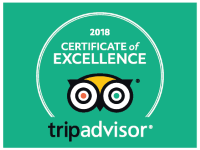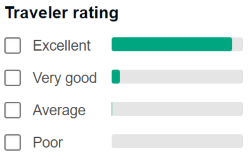Driving in South America – Pleasure and Pain!
Driving in South America can be very challenging, and depending on which country you are travelling through can be scary or even dangerous. Having said that, the pleasure of some of the epic road trips on offer far outweighs the problems, especially if you are well-prepared. Below I have put together some guidance and advice from more than 20 years of driving all over this continent!
Some locations and regions lend themselves to self-drive, but others should perhaps be avoided either due to dangerous road conditions, or lunatic drivers. Also, being driven around by a tour company on certain days will give you a much better experience, for example on our wine tours, or on extreme routes such as our Puna trips where your hire car would fall to pieces.
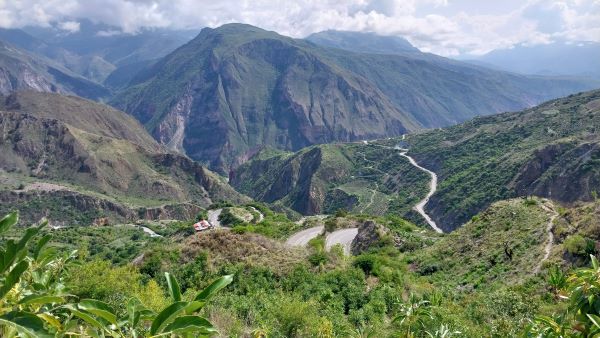
Where might it be nice (and relatively easy) to drive?
Chile is the first answer to this question. Chileans do not drive like stereotypical Latinos, they have good road manners on the whole and generally adhere to the rules of the road, although they do seem to drive over the speed limit a lot.
Always remember to check that your rental car has a spare wheel, jack, warning triangle etc. If you drive sensibly it is very unlikely you will have any issues but it’s always better to make sure you are covered.
Chile has excellent road infrastructure compared with much of Latin America, the tolls are somewhat expensive but you do get what you pay for. The northern part of the country is the Atacama desert, the driest place on the planet. Heading south from Arica, the Panamerica highway is one lane each way until you get to La Serena (where tolls start). Service stations can often be 100km apart, so make sure you fill the tank when you can in the north and carry water and food.
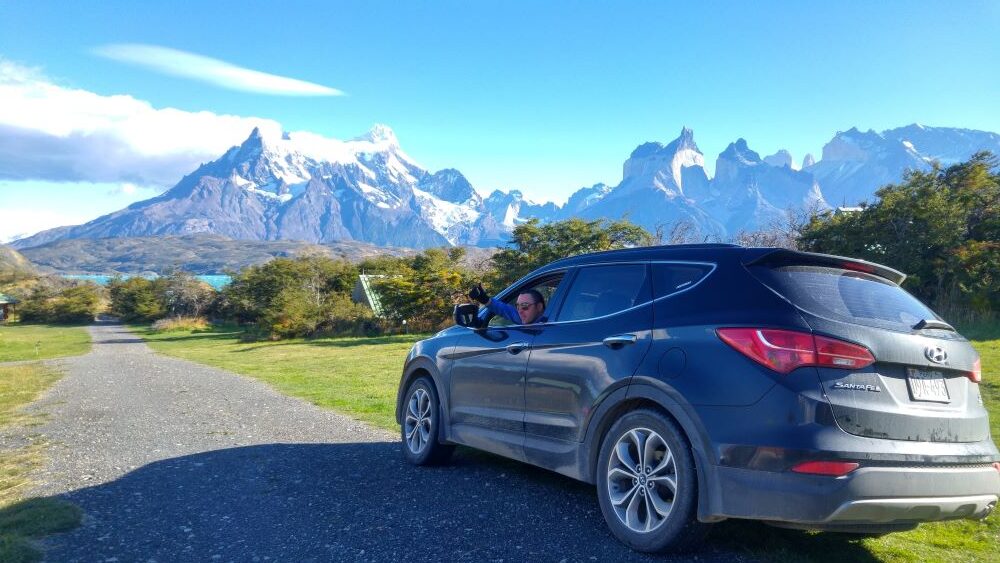
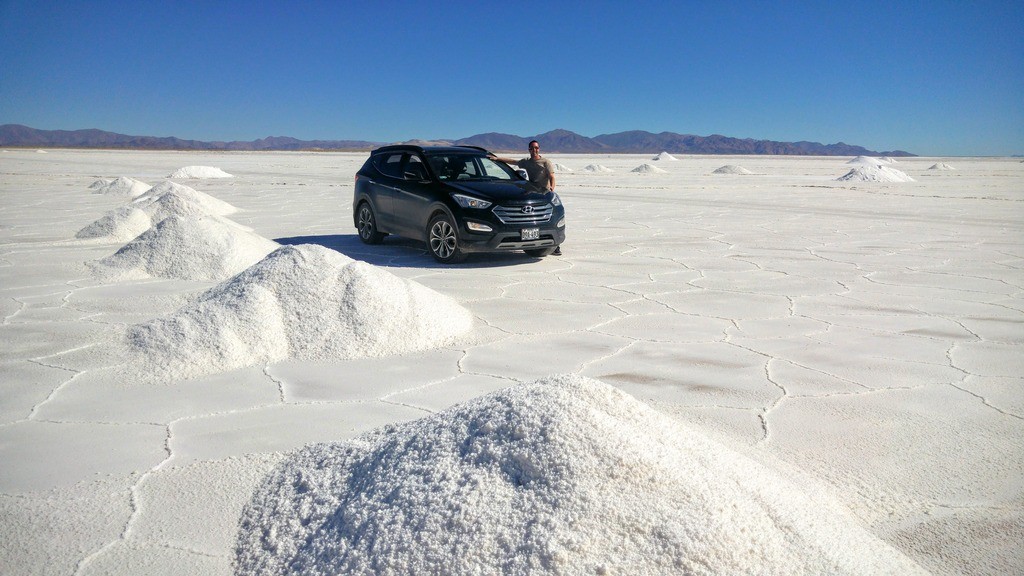
Patagonia is an amazing place to drive, both on the Chilean side and within Argentina. It is a truly stunning part of the world. Again, service stations may be few and far between, so keep your tank full when you can (so you don’t have to search for a jerrycan as you see me doing below). Also, some roads will be gravel so don’t drive too close to traffic ahead and be aware of heavy trucks passing you as stones can fly up and break your windscreen.
Note: Make sure you have insurance that covers damage to wheels and windscreens while driving in South America, as this is likely to happen. We drove our Peruvian vehicle down to Patagonia, and some minor damage occurred, including a goat jumping on the car! The notes about fuel and stones are particularly relevant for the Carretera Austral in Chile. What a beautiful stretch of road, remote and wild, and a true pleasure to drive. But you need to be patient as roadworks can often hold you up for hours as they continue paving more stretches.
Argentina is a place we love visiting and driving there is mostly quite easy. The roads are not as good as those of Chile and in general services and infrastructure is at a lower level than its neighbour, but compared with Peru, Ecuador and Bolivia the standard is still quite high. Tolls and fuel are quite cheap also, which is a major bonus.
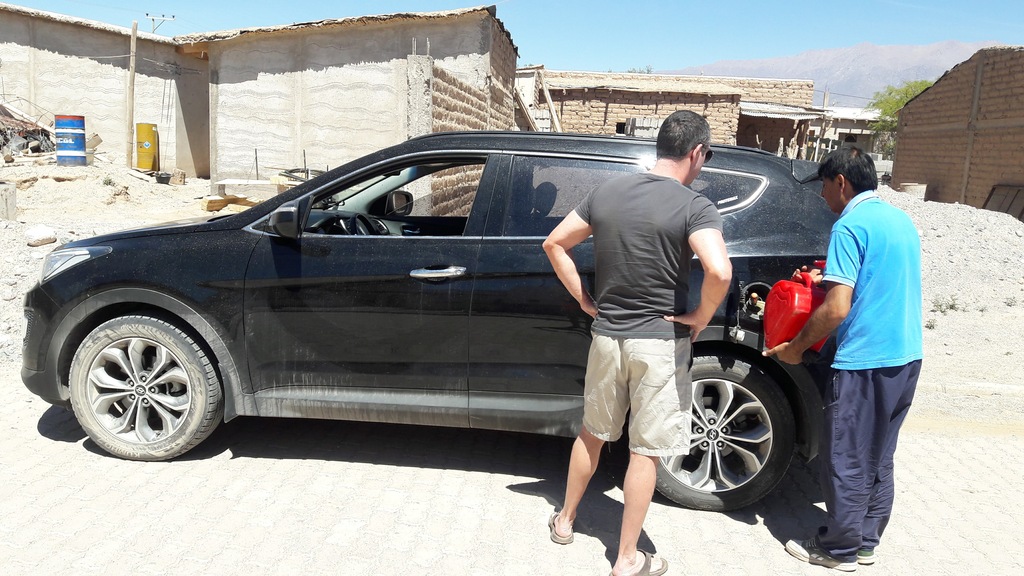
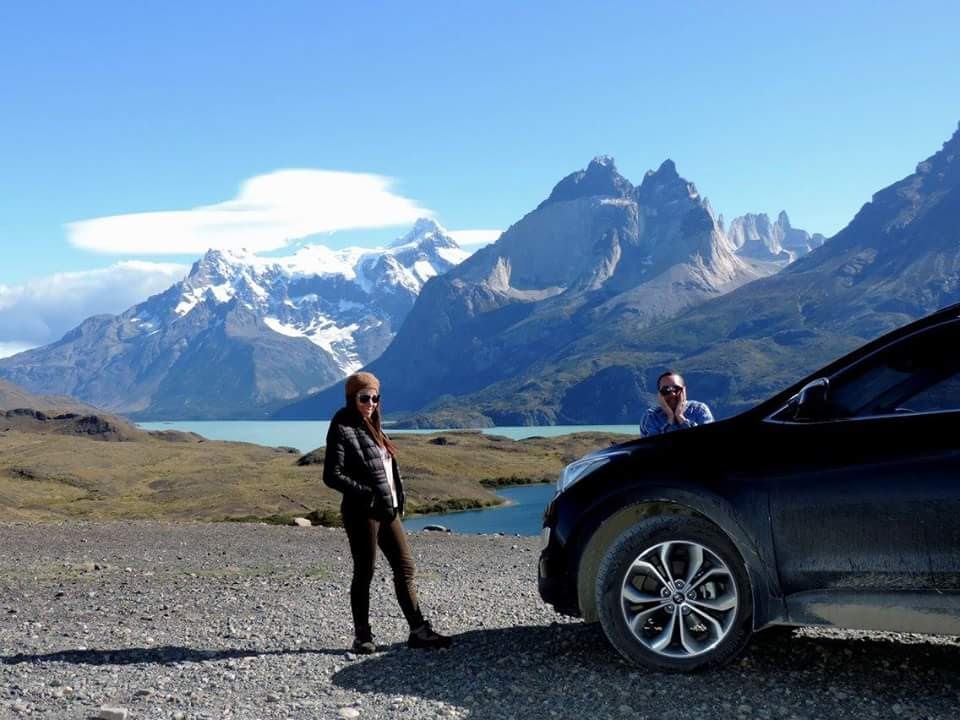
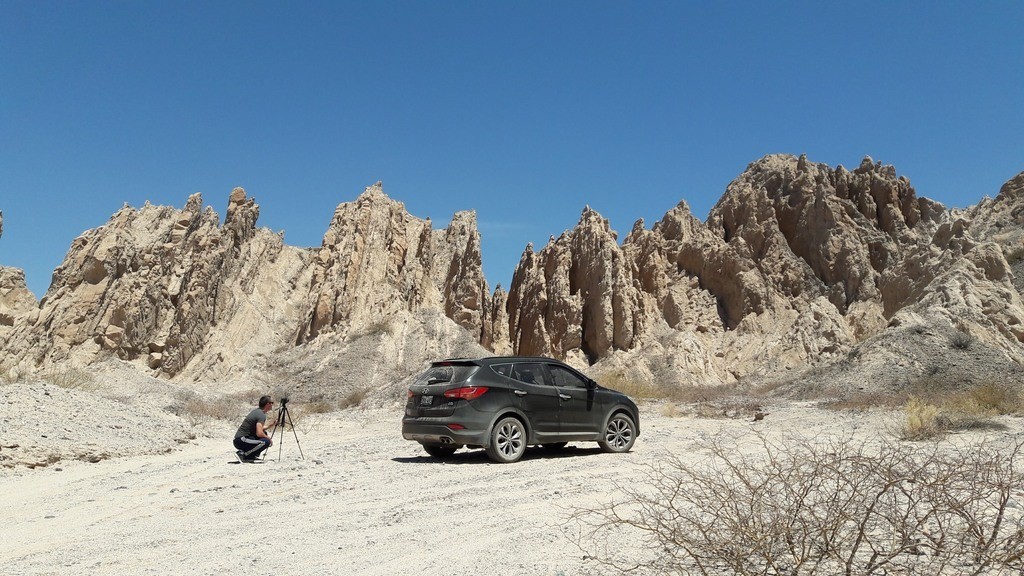
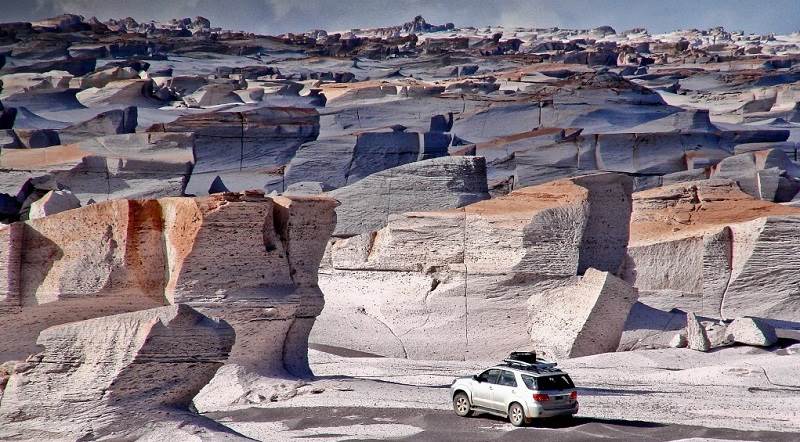
Three main areas of tourism interest where someone might consider renting a car are the Salta and Humahuaca region, the area around Bariloche and the far south in Patagonia. Bariloche would be a simple drive in your own car, but Patagonia could be a little more challenging as some routes are remote and unmade. But the most challenging area would be getting off the beaten route around the Salta region, especially the high Puna.
DO NOT attempt to take your own rental car up to the high Puna, you definitely need to go with a tour company. This route will probably destroy your hire car if it’s not a robust 4×4 and you are likely to become lost and perhaps into serious trouble. Some of the unmade routes around Cachi or Humahuaca can be done in a rental car, but please take your time to avoid punctures or skidding off the road.
The Salta to Cafayate is a well-worn route for wine lovers and the drive is delightful and highly recommended. The main route through the Humahuaca area is also very good and the views are stunning, but if you take the road to Cachi several parts of the road are unmade and very bumpy, so give yourself plenty of time driving at 50km per hour.
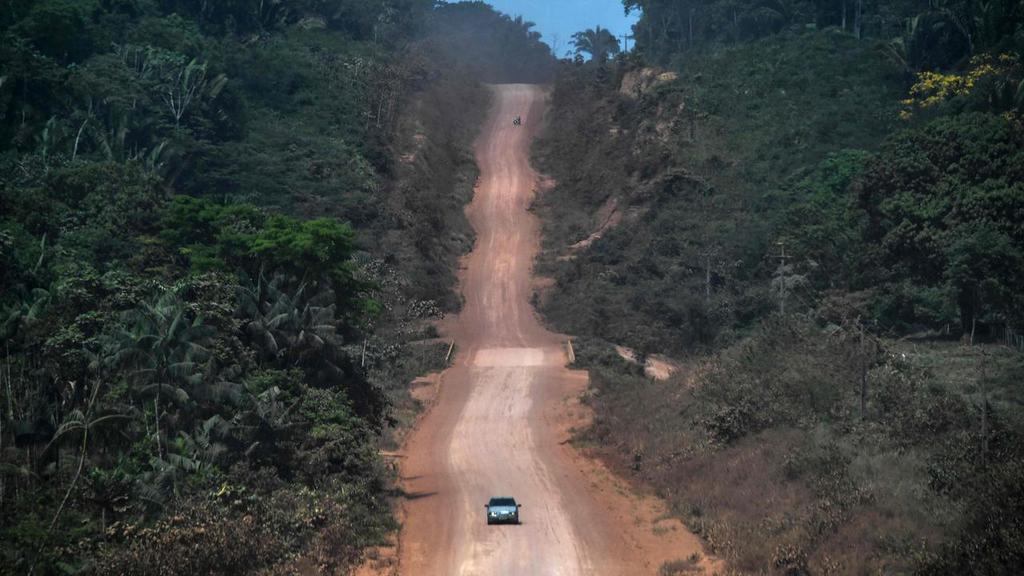
Uruguay is reached easily from Buenos Aires on the Buquebus ferry and is a no-stress destination for road trips. The main roads and secondary routes are in great condition and people drive very sensibly, so enjoy. One thing to note is that you will need to download an app to pay for the tolls on some of the main highways if you are in a foreign car. Toll stations do not accept cash but you have a few days to make a payment against your “account” at payment points in most cities. A car rented in Uruguay will come with the toll system installed.
Brazil has some really good road infrastructure, especially in the southern states. But virtually no-one will speak English so keep your smartphone translator handy if you do not speak Portuguese.
Police and Paperwork
Police interactions should always be respectful, and being so really helps the situation if you have done something wrong. If you have no Spanish (or Portuguese) then smile and hand over your car documents and driving license. Make sure you have your insurance documents handy, and check before arriving if you need an international driving permit or a translation of your licence.
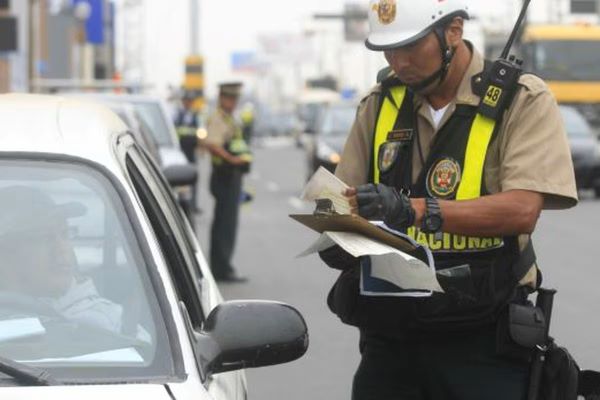
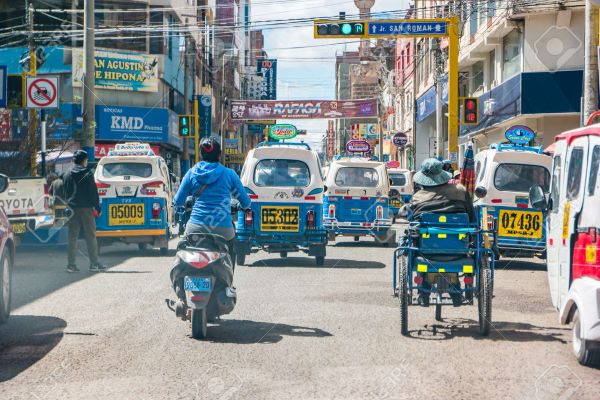
If you speak Spanish the police in some countries may look for a bribe to get you out of the potential fine, so probably best to pretend you don’t speak the local language. Don’t try a bribe in Chile for sure, you will be hauled off to the police station. In the Andean countries, the practice of bribes is common for many things and the bribe will be much less than the fine (I have heard!).
Where might it be difficult to drive?
Peru is the country I know most about. When I moved to Peru I felt like I had to learn to drive all over again, and even though I took new practical and theory tests to get my Peruvian license, the reality of day-to-day driving is very different from the theory.
The vast majority of Peruvian drivers have never been to a developed country and have never witnessed what one should drive like. The middle classes and the elite do drive slightly better; they have more costly cars and have seen people in other countries respect rules, which probably helps. However, there are not many fender benders in Peru as people are aggressive yet defensive all the time.
Some of the list of observations below could apply to several countries but Peru requires them all:
- Do everything you can to avoid driving at night. You may have to set off quite early—note point 2.
- Keep your eyes on the road surface for potholes, speed bumps, dogs, children, drunks etc.
- Don’t drive fast, not because of fines necessarily but because you may not see the items in point 2.
- Turn signals are not used/wrongly used, be aware that drivers make sudden, random turns.
- Turns are often made from the wrong lanes, far right lane turning left for example, and note point 4.
- Someone oncoming and flashing their lights means “I am coming through, get out of my way”.
- Blowing of horns happens ALL the time, impatience is rife – do not be offended, it’s no big deal.
- Speed limits are not respected – even in Chile – although Uruguay and Brazil seem more calm.
- Drivers may shout at you – again, do not be offended and respond, no one really cares anyway.
- In petrol stations you won’t have to do self-service – someone will fill up for you, don’t tip them.
- Many kinds of motorized vehicles and animal-powered transport will be where they shouldn’t be.
- When planning travel remember to look at the terrain – the Andes make the trip 3 times longer.
- Infrastructure in the Andean nations is nothing like southern cone countries – pack supplies.
- Often people will overtake on blind bends – just hold back and stay away from the madness.
- Be very careful on the hundreds of switchbacks in the Andes – trucks will take up the whole road.
- Drivers don’t stop for pedestrians in Peru and Bolivia – but in Chile and Uruguay they will
If it seems like it’s dangerous to drive in Peru then you have the correct idea but I have driven here for 24 years and only had one minor crash and ran over a dog just once (which is more than enough!), neither was my fault really – hence pay head to the list above. If you keep your wits about you the beauty of the countryside is truly stunning and well worth the effort.

